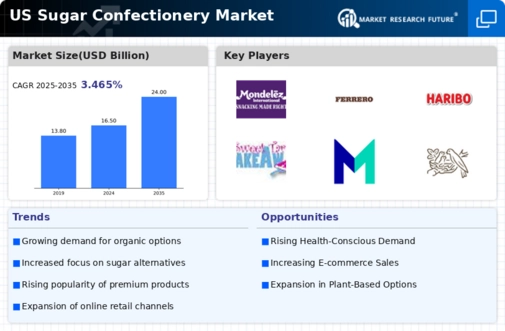Rising Obesity Rates
The increasing prevalence of obesity in the United States has led to a heightened awareness of dietary choices among consumers. As obesity rates continue to rise, individuals are actively seeking alternatives to traditional sugary snacks. This trend is particularly evident in the sugar free-confectionery market, where products are perceived as healthier options. According to recent data, approximately 36% of adults in the US are classified as obese, prompting a shift towards low-calorie and sugar-free products. The sugar free-confectionery market is thus experiencing a surge in demand as consumers prioritize their health and well-being, leading manufacturers to innovate and expand their offerings to cater to this growing segment.
Influence of Dietary Trends
Dietary trends such as keto, paleo, and low-carb diets are significantly shaping consumer behavior in the sugar free-confectionery market. As more individuals adopt these dietary lifestyles, the demand for sugar-free products is likely to increase. These trends emphasize the reduction of sugar intake, which aligns perfectly with the offerings in the sugar free-confectionery market. Manufacturers are responding by developing products that cater to these specific dietary needs, thus expanding their consumer base. The alignment of product offerings with popular dietary trends may enhance market growth, as consumers actively seek out snacks that fit their lifestyle choices.
Expansion of Retail Channels
The sugar free-confectionery market is benefiting from the expansion of retail channels, which enhances product accessibility for consumers. With the proliferation of health-focused grocery stores, online platforms, and specialty shops, consumers have greater access to a diverse range of sugar-free products. This increased availability is likely to drive sales and encourage trial among new customers. Furthermore, the sugar free-confectionery market is capitalizing on e-commerce growth, allowing for direct-to-consumer sales that cater to the convenience-driven shopper. As retail channels continue to diversify, the market is poised for sustained growth, appealing to a broader audience seeking healthier snack options.
Increased Diabetes Prevalence
The rising incidence of diabetes in the United States is significantly influencing consumer preferences in the sugar free-confectionery market. With over 34 million Americans diagnosed with diabetes, there is a pressing need for products that do not exacerbate blood sugar levels. This has resulted in a marked increase in the demand for sugar-free alternatives, as individuals with diabetes seek safe indulgences. The sugar free-confectionery market is responding to this need by developing a variety of products that cater specifically to diabetic consumers, thereby expanding their market reach. This trend not only addresses health concerns but also promotes inclusivity in the confectionery sector.
Growing Awareness of Clean Label Products
Consumer awareness regarding clean label products is on the rise, with many individuals seeking transparency in ingredient sourcing and production processes. This trend is particularly relevant to the sugar free-confectionery market, where consumers are increasingly scrutinizing labels for artificial ingredients and additives. The demand for products that are perceived as natural and free from harmful substances is driving manufacturers to reformulate their offerings. As a result, the sugar free-confectionery market is witnessing a shift towards cleaner, more transparent formulations, which may enhance consumer trust and loyalty. This movement aligns with broader health trends, as consumers prioritize products that align with their values.






















Leave a Comment